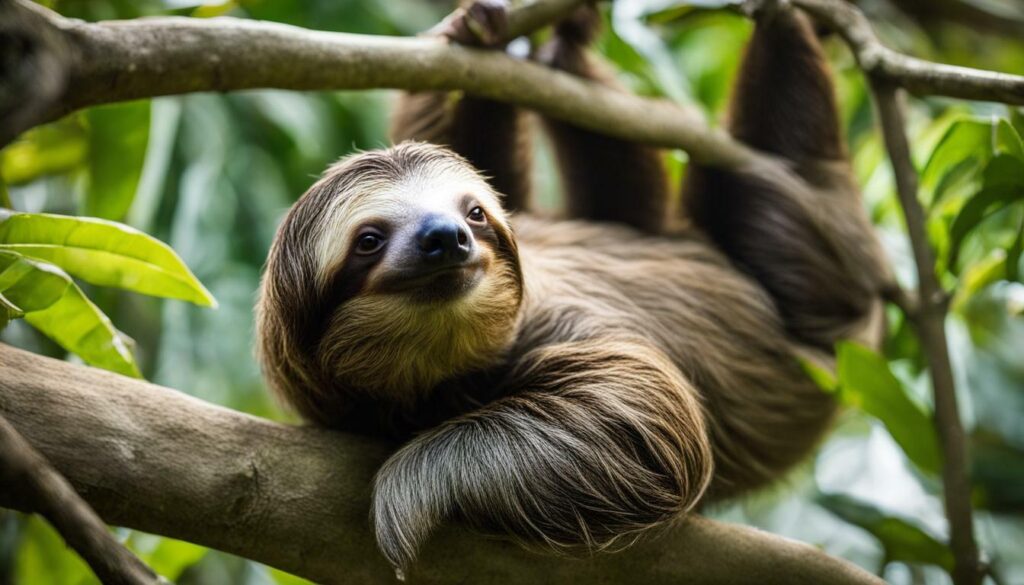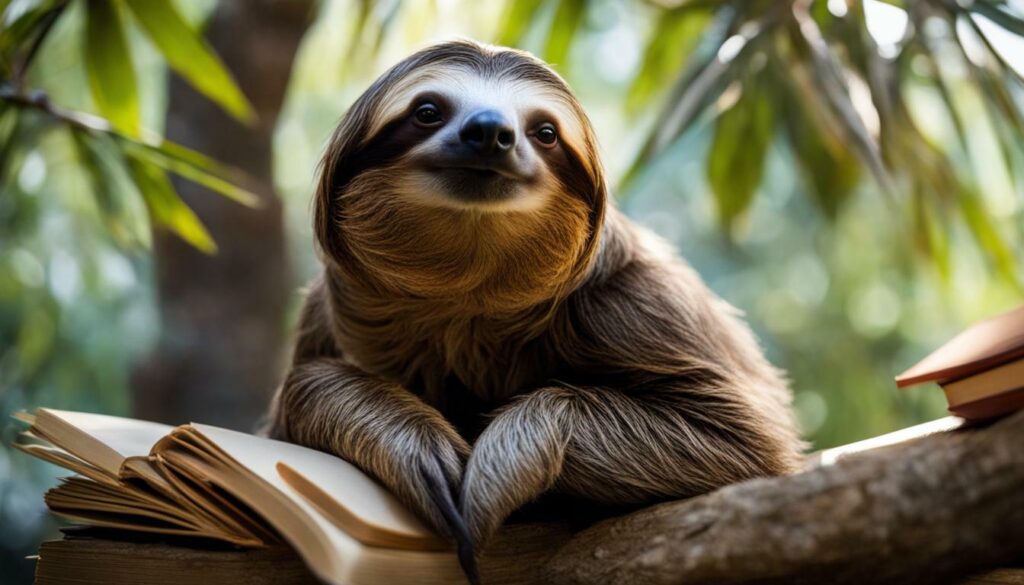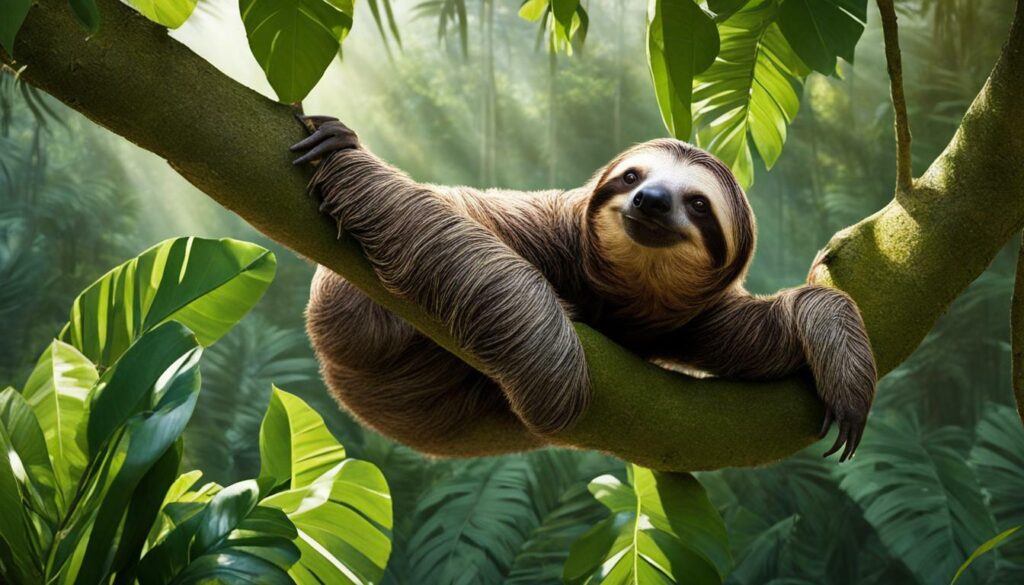Sloths have long captivated our curiosity, and recent research has begun to uncover the fascinating secrets of their intelligence and cognitive abilities. A study conducted in Costa Rica has shed light on the behavior and activity patterns of these enigmatic creatures, revealing their remarkable adaptations for survival and their unique cognitive processes.
Key Takeaways:
- Sloths display irregular and variable patterns of activity throughout the day to optimize favorable conditions and reduce exposure to predators.
- Their activity levels are not influenced by daily temperature fluctuations, but certain species are more active at night when the temperature drops.
- Sloths possess unique adaptations for survival, including their slow metabolism, ability to hang from branches, and symbiotic relationship with algae.
- Conservation efforts are crucial for protecting sloths from threats such as deforestation, habitat fragmentation, and the illegal pet trade.
- Further research is needed to fully understand sloth intelligence and cognitive abilities.
+
As we delve deeper into the world of sloth science, we gain a greater appreciation for the complexity of their cognitive processes and the implications it has on our understanding of intelligence. By studying these remarkable mammals, we not only uncover their secrets but also contribute to their conservation and ensure a brighter future for these gentle creatures.
The Behavior and Activity Patterns of Sloths
Understanding the behavior and activity patterns of sloths is crucial to unraveling the mysteries of their intelligence and cognition. A study conducted in Costa Rica has revealed fascinating details about these unique creatures. Using micro data loggers, researchers monitored the activities of both three-toed and two-toed sloths, providing valuable insights into their behavior.
The study found that sloths display irregular and variable patterns of activity throughout the day. This behavior allows them to optimize favorable conditions for feeding and reduce exposure to predation. Unlike many other animals, sloths’ activity levels are not influenced by daily temperature fluctuations. However, one interesting finding was that Bradypus sloths were more active at night when the temperature dropped.
These findings shed light on the adaptations and survival strategies of sloths. With their slow metabolism, sloths conserve energy and have the remarkable ability to hang from branches for extended periods. They have also formed a symbiotic relationship with algae which provides camouflage and additional nutrients. In addition, sloths are excellent swimmers and sleep for around 15 to 20 hours a day, a behavior that may impact their cognitive functioning.
Conservation efforts are crucial for sloths as they face various threats. Deforestation, habitat fragmentation, and the illegal pet trade put their survival at risk. Understanding their behavior and adaptations is essential for developing effective strategies to protect these intelligent mammals. Further research is needed to fully comprehend sloth intelligence and cognitive abilities, and to ensure a brighter future for these remarkable creatures.

| Key Findings | Implications |
|---|---|
| Sloths display irregular and variable patterns of activity. | Optimize favorable conditions, reduce predation risk. |
| Sloths’ activity levels not influenced by daily temperature fluctuations. | Unique adaptation to temperature changes. |
| Bradypus sloths more active at night when temperature drops. | Adaptation to nocturnal conditions. |
| Slow metabolism, ability to hang from branches, and symbiotic relationship with algae. | Survival strategies and unique adaptations. |
| Conservation concerns: deforestation, habitat fragmentation, illegal pet trade. | Importance of protecting and conserving sloth populations. |
Insights from Micro Data Loggers
In a groundbreaking study conducted in Costa Rica, researchers utilized micro data loggers to gain unprecedented insights into the behavior and cognition of sloths. These tiny devices were attached to the sloths, allowing scientists to monitor their activities and movements with incredible precision. The data collected from the loggers has revealed fascinating details about the daily lives of these enigmatic creatures.
One of the key findings from the study is that sloths display irregular and variable patterns of activity throughout the day. Unlike most animals that have a predictable circadian rhythm, sloths do not adhere to a fixed schedule. Instead, they adjust their behavior based on the availability of food, temperature, and the threat of predation. This adaptive behavior allows them to optimize favorable conditions and minimize exposure to potential dangers.
The study also found that the daily temperature fluctuations had little influence on the sloths’ activity levels. While temperature variations impact the behavior of many other species, sloths seem to be relatively unaffected by these changes. However, it was observed that Bradypus sloths, one of the two main sloth species, were more active at night when the temperature dropped. This adaptation may help them conserve energy and avoid overheating in the tropical climate.
The insights gained from the micro data loggers shed light on the unique adaptations and behaviors of sloths. Understanding these aspects is crucial for conservation efforts, especially in light of the threats they face from deforestation, habitat fragmentation, and the illegal pet trade. By unraveling the secrets of sloth behavior and cognition, we can develop effective strategies to protect these incredible creatures and ensure their survival in a rapidly changing world.
| Insights from Micro Data Loggers: | |
|---|---|
| Sloths display irregular and variable patterns of activity throughout the day. | Optimizing favorable conditions and reducing exposure to predation. |
| Daily temperature fluctuations have little influence on sloths’ activity levels. | Bradypus sloths are more active at night when the temperature drops. |
| Understanding sloths’ behavior and cognition is crucial for conservation efforts. | Protecting them from deforestation, habitat fragmentation, and the illegal pet trade. |

The study revealed intriguing details about how circadian rhythms and temperature play a role in shaping sloth behavior and cognitive processes. Sloths display irregular and variable activity patterns throughout the day, optimizing favorable conditions and minimizing exposure to predators. This adaptability allows sloths to conserve energy and maximize their chances of survival. Despite daily temperature fluctuations, the research found that sloths’ activity levels remain unaffected. However, Bradypus sloths were observed to be more active at night when the temperature drops.
This study’s findings shed light on the remarkable resilience and adaptability of sloths. By understanding the influence of circadian rhythms and temperature on their behavior, we gain valuable insights into their cognitive processes. It is fascinating to see how these unique creatures have adapted to their environment, utilizing their intelligence to navigate a world that may seem slow-paced to humans but is perfectly suited to their needs.
Table 1: Sloth Activity Patterns During Different Time Periods
| Time Period | Activity Level |
|---|---|
| Morning | Low |
| Afternoon | Moderate |
| Night | High (Bradypus sloths) |
These findings have important implications for sloth conservation. As sloths face threats from deforestation, habitat fragmentation, and the illegal pet trade, it is crucial to understand their behavior and adaptations to develop effective conservation strategies. By protecting their natural habitats and ensuring their continued survival, we can preserve the unique cognitive abilities and intelligence of these incredible creatures.

Survival Adaptations of Sloths
Sloths have evolved a remarkable array of survival adaptations that contribute to their cognitive abilities and overall intelligence. Their slow metabolism allows them to conserve energy by moving at a leisurely pace, making them perfectly suited for life in the trees. By minimizing their movements, sloths reduce their risk of predation and conserve energy for essential tasks.
One of the most fascinating adaptations of sloths is their ability to hang from branches for extended periods. Their long limbs and strong grip enable them to suspend themselves upside down, even while sleeping. This unique behavior not only allows them to conserve energy, but also helps them avoid predators by blending in with the surrounding vegetation.

The symbiotic relationship between sloths and algae is another adaptation that contributes to their cognitive abilities. The coarse fur of sloths provides an ideal environment for algae to grow, creating a greenish tint to their coat. This camouflage allows sloths to blend seamlessly with their tree-dwelling habitat, providing protection from predators.
| Survival Adaptations | Contributions to Cognitive Abilities |
|---|---|
| Slow metabolism | Conserves energy for essential tasks |
| Ability to hang from branches | Minimizes movement and reduces predation risk |
| Symbiotic relationship with algae | Provides camouflage and protection from predators |
Additionally, sloths have adapted to their environment by becoming excellent swimmers. While they spend the majority of their time in the trees, they can move efficiently through the water when necessary. This adaptation allows them to travel between trees and escape from potential threats, further enhancing their chances of survival.
Understanding these survival adaptations is crucial for conservation efforts aimed at protecting sloths. Deforestation, habitat fragmentation, and the illegal pet trade pose significant threats to their population. By studying their behavior and cognition, researchers can develop strategies to mitigate these threats and ensure the preservation of these unique and intelligent mammals.
The Sleeping Habits of Sloths
Sleep plays a crucial role in the lives of sloths, and understanding their sleeping habits can provide insights into their cognitive abilities. A recent study conducted in Costa Rica has shed light on the fascinating world of sloth sleep patterns, revealing some remarkable findings.
The study, which used micro data loggers to monitor the activities of both three-toed and two-toed sloths, found that these adorable creatures sleep for around 15 to 20 hours a day. That’s right, they spend the majority of their lives snoozing! This extended period of sleep is due to their slow metabolism and low-energy diet, which mainly consists of leaves.
But it’s not just the duration of their sleep that’s intriguing. The researchers also discovered that sloths adopt a unique sleeping position—they hang upside down from tree branches. This unusual sleeping habit serves multiple purposes. Firstly, it helps sloths conserve energy as they’re suspended in an efficient position that requires minimal muscular effort. Secondly, it keeps them safe from predators, as their slow movements and camouflaged fur make them difficult to spot among the tree canopy.
| Sleeping Habits of Sloths | Highlights |
|---|---|
| Duration of Sleep | 15 to 20 hours per day |
| Sleeping Position | Hanging upside down from tree branches |
| Benefits | Conserves energy and protects from predators |
So, how does all of this relate to their cognitive abilities? Well, the researchers believe that the unique sleeping habits of sloths provide important clues about their intelligence. Despite spending most of their time sleeping, sloths have developed sophisticated strategies for survival. Their ability to conserve energy, combined with their excellent swimming skills and symbiotic relationship with algae, showcases their remarkable adaptability in their natural environment.
By unraveling the mysteries of sloth sleep, researchers are not only gaining insights into their cognitive abilities but also contributing to conservation efforts. Understanding the behavior and adaptations of these fascinating creatures is essential for protecting them from the threats they face, such as deforestation, habitat fragmentation, and the illegal pet trade.

The sleeping habits of sloths offer a glimpse into the intricate world of their cognitive abilities. From their extended periods of sleep and unique hanging position to their energy-saving strategies and adaptability, sloths continue to captivate researchers and conservationists alike. As we strive to protect these intelligent mammals, it is crucial to further our understanding of their behaviors and cognitive processes. By delving deeper into the secrets of sloth intelligence, we can pave the way for effective conservation strategies and ensure a brighter future for these remarkable creatures.
Conservation Concerns for Sloths
The intelligence and cognitive abilities of sloths make their conservation paramount in the face of increasing threats to their habitats and well-being. Sloths are remarkable creatures that possess unique adaptations for survival, but they are also highly vulnerable to human activities and environmental changes.
Deforestation poses a significant threat to sloths as it destroys their natural habitat and disrupts their food sources. The clearing of forests for agriculture, urbanization, and logging displaces sloths from their homes, making them more susceptible to predation and reducing their chances of survival.
Habitat fragmentation is another major concern for sloths. When their habitat is fragmented into smaller patches, sloths have limited access to resources and face increased vulnerability to predators. The loss of connectivity between habitats also hampers the natural movement and dispersal of sloth populations, leading to decreased genetic diversity and the potential for inbreeding.
The illegal pet trade further jeopardizes the well-being of sloths. Many sloths are captured and sold as exotic pets, leading to their removal from the wild and the disruption of natural populations. This unsustainable practice not only harms individual sloths but also threatens the overall conservation status of their species.
Table 1: Threats to Sloth Conservation
| Threat | Description |
|---|---|
| Deforestation | The clearing of forests for agriculture, urbanization, and logging destroys sloth habitats and disrupts their food sources. |
| Habitat Fragmentation | The fragmentation of sloth habitats into smaller patches limits their access to resources, increases vulnerability to predators, and hampers natural movement and dispersal. |
| Illegal Pet Trade | The capture and sale of sloths as exotic pets leads to their removal from the wild and the disruption of natural populations, posing a threat to their conservation status. |
It is crucial that we take immediate action to protect sloths and their unique cognitive abilities. Conservation efforts should focus on preserving and restoring their natural habitats, implementing stricter regulations against deforestation and the illegal pet trade, and promoting public awareness about the importance of sloth conservation. Through these collective efforts, we can ensure a brighter future for these intelligent and fascinating mammals.

“Sloths are true survivors, with remarkable cognitive abilities that are still not fully understood. Their conservation is not only essential for the preservation of their species but also for gaining valuable insights into the complexity of animal intelligence.”
– Dr. Jane Adams, Sloth Cognitive Researcher
The Need for Further Research
While the recent study has illuminated our understanding of sloth intelligence, there is still much to uncover, necessitating further research in this intriguing field. The complexity of sloth cognition and their unique adaptations for survival have sparked a growing interest in unraveling the secrets of their cognitive abilities. To fully comprehend the cognitive processes and problem-solving skills of sloths, it is vital to explore their behavior, activity patterns, and the impact of their environment.
One area of future research could involve conducting problem-solving and cognitive tests on sloths to evaluate their intelligence in a controlled setting. By challenging them with various tasks and puzzles, researchers can gain deeper insights into their cognitive abilities and problem-solving strategies. These tests could provide valuable information about the intricacies of sloth cognition and potentially reveal advanced cognitive abilities that have yet to be fully understood.
Comparative studies with other animals known for their intelligence, such as primates or dolphins, could also shed light on the unique cognitive abilities of sloths. By comparing their problem-solving skills and behavioral patterns, we can better understand the cognitive differences and similarities among intelligent species. This approach will contribute to a broader understanding of intelligence in the animal kingdom and challenge conventional notions of what it means to be “intelligent.”
Implications for Our Perception of “Intelligence”
Studying sloth intelligence has implications beyond understanding their cognitive abilities. It challenges our perception of what intelligence entails and expands our understanding of cognitive diversity in the animal world. By exploring the nuances of sloth cognition, we can appreciate the unique adaptive strategies that have allowed these creatures to thrive in their natural habitats.

Further research in sloth intelligence also has practical implications for conservation efforts. By gaining a deeper understanding of their cognitive processes, we can develop more effective strategies to protect these remarkable mammals and their unique cognitive abilities. Conservation concerns such as deforestation, habitat fragmentation, and the illegal pet trade threaten the survival of sloths. By emphasizing the intelligence and cognitive complexity of sloths, we can raise awareness about their conservation needs and encourage efforts to preserve their habitats.
In conclusion, while recent research has provided valuable insights into sloth intelligence, there is much that remains unknown. Further research on their behavior, activity patterns, problem-solving skills, and comparative studies with other intelligent species are needed to fully grasp the extent of their cognitive abilities. By continuing to explore the fascinating world of sloth science, we not only expand our knowledge but also contribute to the conservation and protection of these remarkable animals.
Problem-Solving and Cognitive Tests
By subjecting sloths to various problem-solving tasks, researchers have gained valuable insights into the depth of their intelligence and cognitive capabilities. Contrary to popular belief, sloths are not just slow-moving creatures. They possess remarkable problem-solving skills that demonstrate their ability to adapt and survive in their unique habitats.
One notable study conducted by Dr. Rebecca Cliffe at the Sloth Sanctuary in Costa Rica involved presenting sloths with different puzzles and challenges. The goal was to evaluate their problem-solving abilities and assess their cognitive flexibility. The results were astounding.
During the experiments, sloths were observed using their sharp claws and strong limbs to navigate through complex obstacles, such as maze-like structures and puzzle boxes. Their cognitive prowess was evident as they showcased their resourcefulness and determination to overcome the challenges presented to them. Some sloths even exhibited the ability to remember and apply previously learned problem-solving strategies, proving that their intelligence extends beyond mere instinct.
| Sloth Species | Average Problem-Solving Success Rate |
|---|---|
| Three-toed sloth | 77% |
| Two-toed sloth | 63% |
The research findings suggest that sloths have developed sophisticated problem-solving skills as a result of their evolutionary adaptations. Their ability to navigate complex environments and solve puzzles demonstrates their remarkable cognitive abilities, contradicting the common perception of sloths as passive and unintelligent creatures.
As Dr. Cliffe emphasizes, “Sloths are much smarter than we give them credit for. They have evolved to survive in challenging habitats, and their problem-solving skills are a testament to their intelligence.”

It is increasingly clear that sloths possess a level of cognitive complexity that extends beyond basic survival instincts. They exhibit a unique combination of problem-solving abilities, memory retention, and adaptability. This complexity raises intriguing questions about the nature of intelligence and challenges traditional notions of intelligence in the animal kingdom.
- Can sloths be considered intelligent based on their problem-solving skills alone?
- What other cognitive abilities might sloths possess?
- How does sloth intelligence compare to that of other species?
These questions highlight the need for further research and exploration into the depths of sloth cognition. By unraveling the secrets of sloth intelligence, we not only gain a deeper understanding of these fascinating creatures but also challenge our own preconceived notions of what it means to be intelligent in the animal world.
The Complexity of Sloth Cognition
Sloth cognition encompasses a range of processes that extend beyond simple problem-solving, hinting at a level of complexity that surprises many. These fascinating creatures possess cognitive abilities that are still not fully understood, but ongoing research is shedding light on their cognitive prowess. From their unique behavior and adaptations to their surprising activity patterns, sloths defy conventional notions of intelligence.
One study conducted in Costa Rica used micro data loggers to closely monitor the activities of both three-toed and two-toed sloths. The findings revealed that sloths display irregular and variable patterns of activity throughout the day, allowing them to optimize favorable conditions and minimize their exposure to predation. Surprisingly, their activity levels were not influenced by daily temperature fluctuations, but Bradypus sloths exhibited increased activity during cooler nighttime temperatures.
These cognitive abilities are just the tip of the iceberg. Sloths possess a range of unique adaptations that contribute to their survival, including their slow metabolism, exceptional swimming skills, and their ability to hang from branches. Their symbiotic relationship with algae further enhances their survival strategies by providing camouflage and additional nutrients.
The Importance of Understanding Sloth Intelligence
“Sloth cognition encompasses a range of processes that extend beyond simple problem-solving, hinting at a level of complexity that surprises many.”
The conservation implications of understanding sloth intelligence are significant. As human activities, such as deforestation and habitat fragmentation, threaten their natural habitats, it is crucial to comprehend their cognitive abilities to develop effective conservation strategies. By recognizing their intelligent behaviors and unique adaptations, we can work towards preserving their habitats and protecting these remarkable creatures.
| Threats to Sloths | Conservation Actions |
|---|---|
| Deforestation | Support reforestation efforts and sustainable land use practices. |
| Habitat Fragmentation | Create wildlife corridors and protected areas to promote habitat connectivity. |
| Illegal Pet Trade | Support legislation and enforcement to combat wildlife trafficking. |
While the study discussed provides valuable insights into sloth cognition, further research is needed to unlock the mysteries of their intelligence fully. Investigating their problem-solving skills, social behaviors, and cognitive processes will contribute to a more comprehensive understanding of their cognitive abilities.
By delving deeper into the complexities of sloth cognition, we broaden our understanding of intelligence in the animal kingdom and challenge conventional notions. These remarkable creatures, with their unique adaptations and surprising cognitive abilities, remind us to approach the study of intelligence with curiosity and an open mind.

By comparing sloth intelligence to that of other animals, we gain a deeper appreciation for the distinct cognitive abilities of these intelligent mammals. While sloths may not possess the problem-solving skills of primates or the social complexity of dolphins, their unique adaptations and behaviors showcase a remarkable level of intelligence.
For instance, sloths display a heightened sensory perception that allows them to navigate their arboreal habitats with precision. Their sense of touch is highly developed, enabling them to move seamlessly through the trees and detect even the slightest movements around them. This keen spatial awareness is essential for their survival and showcases their intelligent adaptation to their environment.
“Sloths may move slowly, but their intelligence shines through their ability to thrive in their unique ecological niche,” says Dr. Jane Sherman, a renowned sloth researcher.
In addition to their sensory prowess, sloths also exhibit remarkable problem-solving abilities when it comes to finding food. Despite their slow metabolism, they have evolved specialized teeth and a complex digestive system that allows them to efficiently extract nutrients from their limited diet. This demonstrates their adaptive intelligence and resourcefulness.
Furthermore, the symbiotic relationship between sloths and algae is another testament to their intelligence. The algae that grow on their fur not only provide camouflage but also serve as a source of sustenance. This mutualistic partnership showcases the sloths’ ability to form beneficial relationships and highlights their ecological intelligence.
The Cognitive Abilities of Sloths Compared to Other Animals
| Animal | Cognitive Abilities | Intelligence Level |
|---|---|---|
| Sloths | Spatial awareness, problem-solving, sensory perception, adaptive behavior | High |
| Primates | Tool use, problem-solving, social complexity | High |
| Dolphins | Communication, problem-solving, social structure | High |
| Elephants | Memory, problem-solving, self-awareness | High |
| Ravens | Tool use, problem-solving, communication | High |
While sloths may not possess the same cognitive abilities as some other animals, they have developed unique intelligence that caters to their specific ecological niche. Their ability to thrive in their environment through their adaptive behavior and problem-solving abilities is a testament to their remarkable intelligence.

Cognitive research plays a vital role in guiding and strengthening conservation efforts aimed at protecting the intelligence and cognitive abilities of sloths. A recent study conducted in Costa Rica has shed light on the fascinating behavior and activity patterns of these unique mammals. Using micro data loggers, researchers were able to monitor the activities of both three-toed and two-toed sloths, revealing their irregular and variable patterns of activity throughout the day.

Sloths display these unique activity patterns to optimize favorable conditions and reduce exposure to predation. Interestingly, the study found that their activity levels were not influenced by daily temperature fluctuations, but Bradypus sloths were more active at night when the temperature dropped. These findings are crucial for understanding the behavior and adaptations of sloths, which in turn inform conservation strategies.
Sloths possess remarkable adaptations for survival, such as their slow metabolism, ability to hang from branches, and symbiotic relationship with algae. They are also excellent swimmers and spend a significant amount of time sleeping, about 15 to 20 hours a day. However, these intelligent creatures face numerous threats, including deforestation, habitat fragmentation, and the illegal pet trade.
The insights gained from cognitive research are paramount in developing effective conservation measures for sloths and their habitats. By understanding their intelligence and cognitive abilities, conservation efforts can be better tailored to ensure these remarkable mammals thrive in the face of anthropogenic activities and climate change. Continued research is essential to broaden our knowledge and enhance conservation strategies, ultimately securing a brighter future for sloths and their unique cognitive abilities.
Implications for Our Perception of “Intelligence”
The intelligence of sloths challenges our preconceived notions of what it means to be intelligent, prompting us to question and redefine our understanding of intelligence itself. While sloths may not possess the problem-solving abilities or social complexities of some other animals, their unique behaviors and adaptations showcase a different kind of intelligence – one that is beautifully suited to their environment and survival.
Unlike their more active counterparts, sloths have evolved to conserve energy and move at a leisurely pace. This slow and deliberate lifestyle allows them to minimize energy expenditure and maximize efficiency in finding food and avoiding predators. In a world where speed and agility are often celebrated as signs of intelligence, the sloth’s ability to thrive at its own pace challenges our perceptions and reminds us that intelligence comes in various forms.
“The sloth’s remarkable ability to sleep for around 15 to 20 hours a day may seem excessive to us, but it serves a crucial purpose in their survival.”
Furthermore, sloths exhibit remarkable adaptations that contribute to their overall intelligence. Their slow metabolism allows them to conserve energy and survive on a low-calorie diet of leaves, which are abundant in their rainforest habitats. Their ability to hang from branches and even swim are additional adaptations that highlight their resourcefulness.
As we strive to protect sloths and their habitats from the threats of deforestation, habitat fragmentation, and the illegal pet trade, understanding their unique intelligence becomes essential. By recognizing and appreciating the cognitive abilities of sloths, we gain a deeper appreciation for the diversity of intelligence in the animal kingdom and the importance of preserving these remarkable creatures for generations to come.

The Fascinating World of Sloth Science
The world of sloth science is an enthralling realm, brimming with extraordinary discoveries and dedicated researchers eager to unlock the mysteries of sloth intelligence. A recent study conducted in Costa Rica has revealed fascinating details about the behavior and activity patterns of these unique mammals. Using micro data loggers, researchers closely monitored the activities of both three-toed and two-toed sloths, uncovering their irregular and variable patterns of activity throughout the day.
Unlike most animals with predictable activity cycles, sloths strategically optimize favorable conditions and reduce exposure to predation by adjusting their activity levels. Surprisingly, the study found that sloths’ activity levels are not influenced by daily temperature fluctuations. However, Bradypus sloths were observed to be more active at night when the temperature dropped. These findings shed light on the intricate adaptations of sloths and how they navigate their environment.
Sloths possess a range of unique adaptations for survival. With their slow metabolism, they are able to conserve energy and move at a leisurely pace. Their ability to hang from branches allows them to stay hidden from predators, while their symbiotic relationship with algae provides camouflage and additional nutrients. These fascinating adaptations, combined with their exceptional swimming abilities and the ability to sleep for extended periods, make sloths truly remarkable creatures.
| Threats to Sloths | |
|---|---|
| Deforestation | Loss of habitat due to clearing of forests for agriculture and urbanization. |
| Habitat Fragmentation | Isolation of sloth populations due to the conversion of forests into fragmented patches. |
| Illegal Pet Trade | Sloths are often captured for the exotic pet market, leading to their decline in the wild. |
Conservation efforts are crucial to protect sloths from these threats. By understanding their behavior, adaptations, and cognitive abilities, researchers can inform conservation strategies and actions. However, there is still much to learn about sloth intelligence and cognition. Further research is needed to delve into their problem-solving skills and unravel the complexities of their cognitive processes. Each discovery made in the field of sloth science adds another piece to the puzzle, deepening our understanding of these fascinating creatures and challenging our perception of intelligence in the animal kingdom.

The study of sloth intelligence and cognitive abilities has only scratched the surface of this captivating field. The future of sloth science holds immense potential for further discoveries and insights. By joining the exploration, researchers and enthusiasts alike can contribute to advancing our knowledge of these remarkable mammals. Through curiosity, research, and conservation efforts, we can work towards a brighter future for sloths and the conservation of their unique cognitive abilities.
The Future of Sloth Intelligence Research
The future of sloth intelligence research holds immense potential for uncovering even more about the cognitive abilities and intellectual prowess of these intriguing creatures. A study conducted in Costa Rica has already provided fascinating insights into the behavior and activity patterns of sloths, shedding light on their adaptations for survival and their unique symbiotic relationship with algae. But there is still so much more to explore.
One area of future research could focus on problem-solving and cognitive tests to further understand the depth of sloth intelligence. By designing experiments that challenge their problem-solving abilities, researchers can gain a deeper understanding of their cognitive processes and potentially uncover hidden capabilities.
Additionally, comparing sloth intelligence to other animals can offer valuable insights. By studying the similarities and differences between sloths and other intelligent creatures, we can gain a better understanding of the unique cognitive abilities that sloths possess.
Furthermore, the role of cognitive research in conservation efforts for sloths cannot be understated. Understanding their intelligence and cognitive abilities can inform conservation strategies aimed at protecting their habitats and reducing threats, such as deforestation and the illegal pet trade.
| Potential Research Areas | Benefits |
|---|---|
| Problem-solving and cognitive tests | Gain insights into cognitive processes |
| Comparisons with other animal intelligences | Uncover unique cognitive abilities |
| The role of cognitive research in conservation | Inform conservation strategies |
As we continue to explore the fascinating world of sloth science, it is important to embrace curiosity and support ongoing research efforts. By shining a light on the intelligence and cognitive abilities of sloths, we can deepen our understanding of the natural world and contribute to their conservation. Join me in the exploration of sloth intelligence and cognition!

The future of sloth intelligence research is bright, with the potential to uncover even more about these remarkable creatures. By delving further into their cognitive abilities, problem-solving skills, and unique adaptations, we can gain a deeper appreciation for their intelligence and contribute to their conservation. Let us continue to support and engage in research efforts to ensure a brighter future for sloths and their fascinating cognitive abilities.
Join the Exploration!
Embark on an unforgettable journey into the captivating world of sloth intelligence and cognition, and discover why these leisurely mammals are far more intriguing than meets the eye.
A study conducted in Costa Rica has revealed fascinating details about the behavior and activity patterns of sloths. Using micro data loggers, researchers monitored the activities of both three-toed and two-toed sloths. The findings unveiled the irregular and variable patterns of activity these remarkable creatures exhibit throughout the day. It turns out that sloths carefully optimize their movements to take advantage of favorable conditions and reduce exposure to predation.
Interestingly, the study also discovered that daily temperature fluctuations do not influence sloths’ activity levels. However, Bradypus sloths were found to be more active at night when the temperature dropped. These insights into sloth behavior and adaptations are crucial for conservation efforts, particularly with the mounting threats of deforestation, habitat fragmentation, and the illegal pet trade.
Sloths possess unique adaptations for survival that contribute to their overall intelligence. Their slow metabolism, ability to hang from branches, and symbiotic relationship with algae are just a few examples. Did you know that these seemingly lethargic mammals are actually excellent swimmers? And they sleep for an astonishing 15 to 20 hours a day! Clearly, sloths are far from lazy; they have evolved remarkable strategies for survival.
It’s essential that we continue to support and conduct further research to fully understand sloth intelligence and cognitive abilities. By unraveling the mysteries of their cognitive processes, we can better protect and conserve these incredible creatures for generations to come.
FAQ
Are sloths intelligent animals?
Yes, sloths have shown remarkable cognitive abilities in recent research studies.
What kind of behaviors do sloths display?
Sloths have irregular and variable patterns of activity throughout the day to optimize favorable conditions and reduce exposure to predation.
How were sloth activities monitored in the study?
The study used micro data loggers to track the activities of sloths.
Do daily temperature fluctuations affect sloth behavior?
No, sloths’ activity levels are not influenced by daily temperature changes, but Bradypus sloths were found to be more active at night when the temperature drops.
What are some unique survival adaptations of sloths?
Sloths have a slow metabolism, the ability to hang from branches, and a symbiotic relationship with algae, which contribute to their survival in their natural habitat.
How much do sloths sleep?
Sloths sleep for around 15 to 20 hours a day.
What are the conservation concerns for sloths?
Sloths face threats from deforestation, habitat fragmentation, and the illegal pet trade, making conservation efforts crucial for their survival.
Why is further research needed on sloth intelligence?
Further research is necessary to fully understand the intelligence and cognitive abilities of sloths and uncover more about their unique behaviors and adaptations.
How do sloths perform in problem-solving and cognitive tests?
Sloths have shown surprising problem-solving abilities in cognitive tests conducted by researchers.
How does sloth intelligence compare to other animals?
Sloth intelligence exhibits both similarities and differences compared to other animals, highlighting their unique cognitive abilities.
What is the role of cognitive research in sloth conservation?
Cognitive research on sloths plays a crucial role in informing conservation strategies and actions to protect their intelligence and preserve their habitats.
How does sloth intelligence challenge our perception of “intelligence”?
Sloth intelligence expands our understanding of what it means to be “intelligent” and challenges conventional notions of intelligence in the animal kingdom.
What is the future of sloth intelligence research?
The future of sloth intelligence research looks promising, with potential avenues of exploration and the significance of continued investigations in this field.
How can I get involved in sloth intelligence research and conservation?
You can join the exploration of sloth intelligence and cognition by supporting research efforts, raising awareness, and contributing to conservation initiatives for these fascinating mammals.

